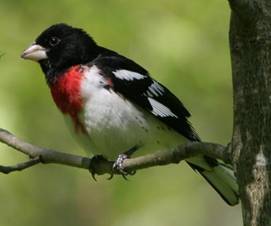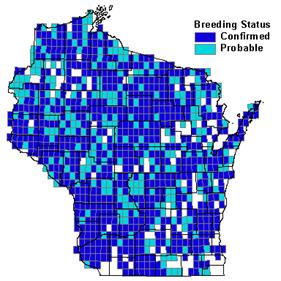Photo by Scott Franke


Status/Protection
- Global Rank: G5 Key to global and state ranks
- State Rank: S5B
- WBCI Priority: PIF
Population Information
Federal BBS information can be obtained at http://www.mbr-pwrc.usgs.gov/bbs/bbs.html by clicking on Trend Estimates and selecting the species in question. All estimates are for 1966-2005.
- Federal Breeding Bird Survey: significant decline
- Federal Breeding Bird Survey (WI): non-significant increase
- Federal Breeding Bird Survey (BCR 23): non-significant decline
- Federal Breeding Bird Survey (BCR 12): significant decline
- WSO Checklist Project: significant increase (1983-2007)
Life History
- Breeding Range: Northeastern British Columbia east across southern Canada and the midwestern states to the Atlantic Coast (Wyatt and Francis 2002).
- Breeding Habitat: Northern Hardwood, Oak, Aspen, Bottomland Hardwood.
- Nest: Loosely constructed cup, average 6 m above ground (Wyatt and Francis 2002).
- Nesting Dates: Eggs: late May to early August (Robbins 1991).
- Foraging: Foliage glean, bark glean, hover-glean, hawks (Ehrlich et al. 1988).
- Migrant Status: Neotropical migrant.
- Habitat use during Migration: Mature and open forests, second-growth forests, forest edges, and mixed forests (Wyatt and Francis 2002).
- Arrival Dates: Early to late May (Robbins 1991).
- Departure Dates: Mid-August to late September (Robbins 1991).
- Winter Range: Southern Mexico, Central America, and western South America (Wyatt and Francis 2002).
- Winter Habitat: Similar to breeding habitat.
Habitat Selection
The Rose-breasted Grosbeak is a forest habitat generalist (Mossman and Lange 1982) that occurs in deciduous and mixed forests, in upland and mesic sites, and in fragmented and contiguous stands (Bond 1957, Wyatt and Francis 2002). It frequents natural forest clearings and forest edges created by streams, roads, and buildings (Wyatt and Francis 2002). Several studies have reported it as area-sensitive while others have documented self-sustaining populations in relatively small (<140 ha) fragmented woodlots (Robbins 1989, Friesen et al. 1999, Burke and Nol 2000, Wyatt and Francis 2002). In Wisconsin, it is most numerous in dry upland forests (Bond 1957, Martinson 2006), but also is found along steep inclines in more mesic forests (Mossman and Lange 1982). It is abundant in 28-45 year-old aspen stands in central Wisconsin (Smith and Payne 1997) and saw-sized white pine, pole-sized jack pine, and regenerating hardwood stands in the Chequamegon National Forest (Danz et al. 2007). Nest sites observed in the Baraboo Hills had only moderate densities of understory and lower-canopy foliage (Mossman and Lange 1982). Nests often are placed in vertical forks of saplings, shrubs, or vines (Robbins 1991, Wyatt and Francis 2002). During migration, the Rose-breasted Grosbeak uses a wide variety of forested and shrub-dominated habitats and also frequents backyard feeders containing sunflower, safflower, and peanuts (Parrish 1997, Wyatt and Francis 2002).
Habitat Availability
Wisconsin is at the core of the Rose-breasted Grosbeak breeding range (Wyatt and Francis 2002) and it breeds throughout the state (Martinson 2006). Although its broad habitat use and tolerance of edges suggest that it is not habitat-limited, reproductive success within the forest fragments and edges that this species frequents deserves more study.
Population Concerns
Wyatt and Francis (2002) listed Wisconsin as one of seven states with the highest relative abundance of this species. Robbins (1991) cites the Rose-breasted Grosbeak as a fairly common to common summer resident in the state. It was frequently encountered during the Wisconsin Breeding Bird Atlas where breeding was confirmed in 60% of the surveyed quads (Martinson 2006). Wisconsin Breeding Bird Survey (BBS) and Checklist Project data both indicate an increasing population trend for the state, although the former is not statistically significant (Rolley 2005, Sauer et al. 2005). While it appears that the Wisconsin population is doing well, this species appears to be declining throughout most of its range (Sauer et al. 2005) and causal factors are not well-known. Although tolerant of human-altered landscapes, few studies have measured the quality of these areas, which may act as ecological sinks.
Recommended Management
Although tolerant of fragmented landscapes, the Rose-breasted Grosbeak would benefit from the protection and restoration of large, unfragmented blocks of structurally complex upland and lowland hardwood forests. Natural disturbances, such as beaver activities, and forest management practices that promote a variety of cover types and successional stages should be encouraged within working forests. Wetland shrub communities also are important to this species and should be integrated into land management planning.
Research Needs
Despite the Rose-breasted Grosbeak being a common and widespread species, research needs are significant. Most of its current biological information is derived from studies conducted in Ontario, thus local studies are needed to better guide management efforts. Studies investigating the reproductive success in habitats of different qualities are warranted. In particular, the viability of populations breeding in fragmented habitats needs evaluation. It is unknown if this species is more limited during the breeding or nonbreeding season; thus more research is needed regarding habitat requirements on the winter grounds (Wyatt and Francis 2002).
Information Sources
- Chequamegon National Forest Bird Survey (NRRI) species account: http://www.nrri.umn.edu/mnbirds/accounts/RBGRa2.htm
- Cornell Lab of Ornithology species account: http://www.birds.cornell.edu/AllAboutBirds/BirdGuide/Rose-breasted_Grosbeak.html
- Great Lakes Bird Conservation probability map: http://www.uwgb.edu/birds/greatlakes/species/rbgrmap2.htm
- Nicolet National Forest bird survey species map: http://www.uwgb.edu/birds/nnf/species/RBGR.htm
- North American Breeding Bird Survey: http://www.mbr-pwrc.usgs.gov/bbs/bbs.html
- Wisconsin Breeding Bird Atlas: http://www.uwgb.edu/birds/wbba/
References
- Bond, R. R. 1957. Ecological distribution of breeding birds in the upland forest of southern Wisconsin. Ecol. Monogr. 27(4): 351-384.
- Burke, D.M. and E. Nol. 2000. Landscape and fragment size effects on reproductive success of forest-breeding birds in Ontario. Ecol. Applic. 10: 1749–1761.
- Danz, N.P., G.J. Niemi, J. Lind, and J.M. Hanowski. 2007. Birds of Western Great Lakes Forests. www.nrri.umn.edu/mnbirds (2 April 2007)
- Ehrlich, P.R., D.S. Dobkin, and D. Wheye. 1988. The birders handbook: a field guide to the natural history of North American birds. Simon & Schuster, Inc. New York.
- Friesen, L., M. D. Cadman, and R. J. MacKay. 1999. Nesting success of neotropical migrant songbirds in a highly fragmented landscape. Cons. Biol. 13(2): 338-346.
- Martinson, T. 2006. Rose-breasted Grosbeak. In Atlas of the Breeding Birds of Wisconsin. (N.J. Cutright, B.R. Harriman, and R.W. Howe, eds.) The Wisconsin Society for Ornithology, Inc. 602pp.
- Mossman, M. J., and K. I. Lange. 1982. Breeding birds of the Baraboo Hills, Wisconsin: Their history, distribution and ecology. Wis. Dep. Nat. Resour. and Wis. Soc. Ornithol., Madison.
- Parrish, J. D. 1997. Patterns of frugivory and energetic condition in Nearctic landbirds during autumn migration. Condor 99: 681-697.
- Robbins, C.S., D.K. Dawson, and B.A. Dowell. 1989. Habitat area requirements of breeding forest birds of the Middle Atlantic states. Wildl. Monogr. 103:1-34.
- Robbins, C.S., J.S. Sauer, R. Greenberg, and S. Droege. 1989. Population declines in North American birds that migrate to the Neotropics. Proc. Natl. Acad. Sci. 86:7658-7662.
- Robbins, S. D., Jr. 1991. Wisconsin birdlife: Population and distribution past and present. Madison, WI: Univ. Wisconsin Press.
- Rolley, R. 2005. Wisconsin Checklist Project. http://dnr.wi.gov/org/land/wildlife/harvest/reports/07checklist.pdf (2 April 2007)
- Sauer, J.R., J.E. Hines, and J. Fallon. 2005. The North American Breeding Bird Survey, Results and Analysis 1966 - 2005. Version 6.2.2006. USGS Patuxent Wildlife ResearchCenter, Laurel, MD.
- Smith, J. H., and N. F. Payne. 1997. Relationship of birds to various age aspen stands. Passenger Pigeon 59: 267-274.
- Wyatt, V. E., and C. M. Francis. 2002. Rose-breasted Grosbeak. The Birds of North America, No. 692 (A. Poole and F. Gill, eds.). The Birds of North America, Inc., Philadelphia, PA.
Contact Information
- Compiler: Tom Klubertanz, tklubert@uwc.edu
- Editors: Kim Kreitinger, K.Kreitinger@gmail.com
